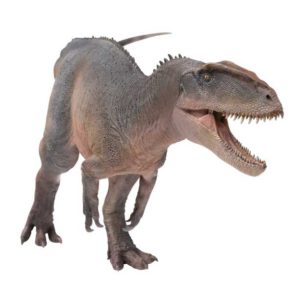Giant Jurassic Dinosaur Discovered In China Thanks to Mapping of New Fossil Sites
China’s Biggest Ever Jurassic Dinosaur Discovered
The discovery of partially articulated fossilised bones of the largest Jurassic dinosaur from China has been announced by a team of Chinese and German scientists. The fossils represent a potentially new genus of long-necked, herbivorous dinosaur similar to the likes of Diplodocus and Apatosaurus, whose fossil remains have been found in Upper Jurassic deposits of the United States. A giant Jurassic dinosaur has been discovered in China.
Giant Jurassic Dinosaur
Although, far from complete and with much of the fossil material still embedded in its sandstone matrix, scientists have estimated that the bones belonged to a giant dinosaur; approximately thirty-five metres in length and weighing perhaps as much as six African elephants. The fossils were found by a palaeontological expedition exploring Jurassic aged sediments in the remote Shanshan county in the northwestern region of Xinjiang Province, a part of the world that has recently provided Chinese scientists with a number of new dig sites for the excavation of dinosaur bones.
A spokesperson for the Chinese Research Society of Palaeontology commented that the fossils were found in strata that dates to around 165 million years ago, the Middle Jurassic, more specifically (Bajocian faunal stage). A number of large Middle Jurassic, long-necked dinosaurs (called sauropods) are known from China. The most complete discoveries have been made in Sichuan Province (central China) and include dinosaurs such as the fifteen-metre-long Datousaurus and the smaller Shunosaurus, noted for its long tail with a club on the end.
The Latest Fossil Discovery
This latest fossil discovery provides evidence of a much larger, sauropod dinosaur, one that would rival the biggest sauropods that have been found elsewhere in the world for the title of the largest dinosaur specimen known from the Middle Jurassic.
The scientists are confident that they will be able to excavate all the fossilised bones out of the sandstone ridge where they are buried, included a row of articulated vertebrae (back bones). Close to these fossils, the field team discovered a single, broken tooth from a large meat-eating dinosaur.
It has been speculated that a meat-eating dinosaur may have fed on the carcase before it was buried. The tooth is slightly re-curved and suggests that it came from an allosaurid, a group of carnivorous dinosaurs that roamed the Northern Hemisphere for much of the Jurassic. The single tooth may have belonged to a dinosaur similar to the eight metre long predator Sinraptor, whose fossilised remains have been found in similar aged rocks in Sichuan Province.
An Illustration of the Carnivorous Dinosaur Sinraptor (Theropoda)
To view models of Chinese dinosaurs including Sinraptor (whilst stocks last): PNSO Models and Figures (Dinosaurs).
Mapping Fossil Locations
The expedition team is composed of experts from Jilin University, Shenyang Normal University and Xinjiangg Geological Survey Institute with support from the Humboldt University (Berlin). Over a six month period the expedition team mapped more than twenty fossil locations and recovered a wide variety of vertebrate fossils, providing scientists with a much better understanding of the climate in this part of the world during the Middle Jurassic.
An Artist’s Illustration of the Giant Jurassic Sauropod
Picture credit: Everything Dinosaur from an original drawing by Mike Fredericks
The north-western part of China, known as the Turpan Basin was once believed to be very arid, but the discovery of this giant herbivore along with fossils of other reptiles such as terrapins indicate that this low lying region had a number of large lakes within it during the Jurassic and the vegetation must have been very lush to permit such a large, herbivorous dinosaur to live there.
Scientists from the Chinese Academy of Sciences are hoping that these new fossil finds will provide them with more information on the climatic conditions in this part of the world 165 million years ago. It may help geologists to pinpoint new reserves of fossil fuels such as gas and oil.
Once the bones have been completely excavated and prepared in a laboratory the palaeontologists will have a better idea as to whether this specimen represents a new species of herbivorous dinosaur. The research team hope to find more evidence of the large theropod that may have scavenged the carcase of this huge Jurassic monster.



